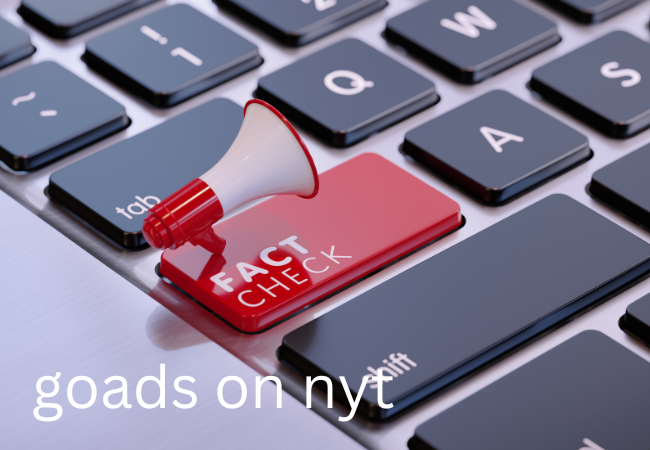Goads on NYT

The term “goads on nyt” might seem unfamiliar at first glance, but it holds significant importance in the realm of journalism and media studies. This article aims to delve into the concept of “goads” as they appear in The New York Times (NYT), exploring their role, impact, and the controversy surrounding their use. Understanding goads is essential for anyone who wants to critically engage with media content and appreciate the nuances of journalistic practices.
What are Goads?
Definition and Historical Background
Goads, in a broad sense, are provocations or stimuli designed to incite a response. Historically, a goad was a tool used to drive livestock, urging them to move forward. In a metaphorical sense, goads have evolved to represent anything that spurs action or thought, particularly in writing and rhetoric.
Different Contexts Where Goads Are Used
In modern contexts, goads are used in various fields, including literature, marketing, and journalism. They can be seen as rhetorical devices that provoke, challenge, or encourage a particular reaction from the audience. This makes them powerful tools for writers and speakers who wish to engage and influence their audience effectively.
NYT: A Brief Overview
History of The New York Times
The New York Times, established in 1851, has grown to become one of the most influential newspapers globally. Known for its comprehensive coverage and in-depth analysis, the NYT has set high standards for journalism.
Its Influence in Media and Journalism
With a vast readership and significant impact on public opinion, the NYT plays a crucial role in shaping narratives and informing the public. Its articles are often seen as authoritative sources, making its use of goads particularly noteworthy.
The Intersection of Goads and NYT
How the Term “Goads” is Applied in NYT Articles
In the context of the NYT, goads are subtle yet powerful elements embedded within articles to provoke thought, elicit emotions, or drive engagement. These can be found in headlines, opening paragraphs, or throughout the text, guiding the reader’s response and interaction with the content.
Examples of Goads Used in Notable NYT Pieces
Examples of goads in NYT articles are plentiful. Whether through a provocative headline about a political scandal or a poignant opening line in a piece about social injustice, the NYT effectively uses goads to capture and maintain reader interest.
Analyzing Specific Examples
Example 1: Political Commentary
In political commentary, goads are often used to highlight contentious issues or criticize policies. For instance, a headline like “Is Democracy Dying?” not only informs but also provokes concern and contemplation among readers.

Example 2: Social Issues
Articles addressing social issues, such as inequality or climate change, often use goads to draw attention to urgent matters. A phrase like “The Silent Crisis We Ignore” serves to awaken readers to the importance of the topic.
Example 3: Economic Discussions
Economic discussions in the NYT may include goads that simplify complex topics while stirring curiosity or concern. An example might be a headline like “The Hidden Costs of Prosperity,” prompting readers to consider the broader implications of economic growth.
Impact of Goads in Journalism
How Goads Influence Public Opinion
Goads are powerful in shaping public opinion. By directing readers’ attention and eliciting emotional responses, they can influence how issues are perceived and discussed. This makes them essential tools in the arsenal of any journalist looking to make a significant impact.
The Ethical Considerations
However, the use of goads also raises ethical questions. While they can enhance engagement and provoke necessary discussions, there’s a fine line between provocative and manipulative. Journalists must balance the need for engagement with the responsibility to provide unbiased and accurate information.
Goads and Reader Engagement
Techniques NYT Uses to Engage Readers
The NYT employs various techniques to engage readers, with goads being a central element. Compelling headlines, evocative imagery, and thought-provoking questions are just a few methods used to draw readers in and keep them hooked.
The Role of Goads in Increasing Readership
Goads play a critical role in increasing readership by making articles more appealing and thought-provoking. They help transform mundane news into engaging stories, ensuring that readers return for more insightful and stimulating content.
Comparing Goads in NYT to Other Publications
Differences and Similarities
While the NYT is renowned for its effective use of goads, other publications also employ similar strategies. However, the style and intensity of goads can vary significantly. Some newspapers may use more sensational goads, while others maintain a more subtle approach.
Case Studies from Other Major Newspapers
Comparative case studies reveal that while publications like The Washington Post or The Guardian also use goads, their execution differs based on editorial policies and target audiences. These differences can provide insights into the varied landscape of journalistic practices.
Criticism and Controversy
Common Criticisms of NYT’s Use of Goads
The NYT’s use of goads has not been without criticism. Some argue that it can border on sensationalism, potentially compromising journalistic integrity. Critics claim that overly provocative goads may mislead readers or overshadow the factual content of the articles.
Public Reactions and Controversies
Public reactions to goads can be mixed. While some readers appreciate the engaging and thought-provoking nature of such articles, others may feel manipulated or misinformed. Notable controversies often arise when goads are perceived to cross ethical boundaries.
The Future of Goads in Journalism
Predictions and Trends
The future of goads in journalism looks set to evolve with changes in media consumption habits. As digital media continues to grow, the use of goads will likely become more sophisticated, integrating multimedia elements to capture audience attention.
The Evolving Role of Media and Goads
As the media landscape changes, the role of goads will adapt. They will remain crucial for engagement but will need to balance provocativeness with trustworthiness to maintain credibility in an increasingly skeptical audience.
Case Studies of Effective Goads
Analysis of Successful Goads
Successful goads are those that provoke thought without misleading. An effective goad often combines a compelling question or statement with robust factual backing, ensuring that it engages without compromising on accuracy.
Lessons Learned from These Examples
Lessons from effective goads highlight the importance of balance. They demonstrate that while goads can draw in readers, maintaining journalistic integrity and providing substantial content are equally important for lasting impact.
Strategies for Identifying Goads
How Readers Can Spot Goads in Articles
Readers can spot goads by looking for provocative language, rhetorical questions, and emotionally charged statements. These elements are typically designed to elicit a strong response, indicating the presence of a goad.
Tips for Critical Reading
Critical reading involves questioning the intent behind provocative statements and seeking out the factual basis for claims. By doing so, readers can appreciate the engagement value of goads while remaining informed and discerning.
Writing with Goads: A Guide for Journalists
Best Practices for Incorporating Goads
Journalists should aim to use goads that enhance rather than overshadow the story. Best practices include ensuring goads are factually accurate, contextually appropriate, and balanced in their provocativeness.
Balancing Engagement with Accuracy
Balancing engagement wit accurahcy is key. While goads should captivate readers, they must not distort the truth. Journalists should strive for goads that provoke thought and discussion based on reliable information.

Goads in Digital Media
The Role of Goads in Online Journalism
In online journalism, goads are vital for capturing attention in a crowded digital space. They often appear in the form of clickable headlines or lead paragraphs designed to draw users into the article.
Social Media and the Spread of Goads
Social media amplifies the reach of goads, enabling articles to go viral. However, this also increases the risk of misinformation, making it crucial for journalists to use goads responsibly and ensure their content is reliable.
Conclusion
Goads play a significant role in journalism, particularly in publications like The New York Times. They serve to engage readers, provoke thought, and drive discussions on important issues. However, their use must be balanced with ethical considerations and a commitment to accuracy. As media continues to evolve, the effective and responsible use of goads will remain essential for maintaining public trust and engagement.
FAQs
What are goads in journalism?
Goads in journalism are provocative elements used to engage readers and provoke thought, often found in headlines and opening paragraphs.
How does the NYT use goads in their articles?
The NYT uses goads to draw attention to key issues, provoke emotional responses, and engage readers through thought-provoking questions and statements.
Can goads be misleading?
Yes, if not used responsibly, goads can mislead by prioritizing provocation over factual accuracy, potentially distorting the readers’ understanding of the issue.
Are goads ethical in journalism?
Goads can be ethical if they are used to enhance engagement without compromising the truth. Journalists must balance provocation with integrity and accuracy.
How can readers critically assess articles with goads?
Readers can critically assess goads by questioning the intent behind provocative statements, seeking factual backing, and considering the broader context of the article.



